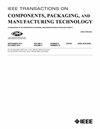浸水冷却用导热绝缘电子封装
IF 3
3区 工程技术
Q2 ENGINEERING, ELECTRICAL & ELECTRONIC
IEEE Transactions on Components, Packaging and Manufacturing Technology
Pub Date : 2025-04-09
DOI:10.1109/TCPMT.2025.3558669
引用次数: 0
摘要
功率密度化使热设计成为未来电气设备发展的关键一步。数据中心和电动汽车等系统正在产生更多的热量,这需要有效的冷却,以保持电子设备的温度低于其极限,并确保可靠性。浸入式冷却已经成为一种很有前途的热管理技术,它使冷却剂更接近发热元件,从而减少热阻抗并改善冷却。虽然在浸没式冷却中使用的介电液体冷却剂不会影响浸没式电气设备的电气性能,但与理想的冷却剂(如水)相比,它们的冷却性能较差。为了使用水作为浸没冷却剂,电子设备需要封装以防止短路。在这里,开发了一种封装方法,将电子设备与周围的水隔离开来,并传播热量以获得更好的冷却。该封装由用于绝缘和散热的氮化铝(AlN)组件和用于保形电绝缘的聚对二甲苯C涂层组成。该封装的电气特性是在直流电压高达600 V的情况下测量长达7天的水泄漏电流。这种封装方法的热性能也通过计算结到冷却剂的热阻来表征。开发的封装设计可以在高功率密度应用中实现,其中热通量超出了标准介电流体可以处理的范围。本文章由计算机程序翻译,如有差异,请以英文原文为准。
Thermally Conductive Electrically Insulating Electronics Packaging for Water Immersion Cooling
Power densification is making thermal design a key step in the development of future electrical devices. Systems such as data centers and electric vehicles are generating more heat, which requires efficient cooling to maintain the electronics at temperatures below their limits and to ensure reliability. Immersion cooling has emerged as a promising thermal management technique that brings the coolant closer to the heat-generating elements, hence reducing thermal impedance and improving cooling. Although the dielectric liquid coolants used in immersion cooling do not compromise the electrical performance of the submerged electrical devices, their cooling performance is inferior compared to ideal coolants such as water. To use water as an immersion coolant, the electronics need to be encapsulated to prevent short circuits. Here, a packaging approach is developed that insulates the electronics from the surrounding water and spreads heat for better cooling. The package consists of an aluminum nitride (AlN) component for insulation and heat spreading, and a Parylene C coating for conformal electrical insulation. The package is characterized electrically by measuring the leakage current in water under dc voltages up to 600 V for periods of up to seven days. The thermal performance of this packaging method is also characterized by calculating the junction-to-coolant thermal resistance. The developed packaging design can be implemented in high-power-density applications where the heat flux is beyond what standard dielectric fluids can handle.
求助全文
通过发布文献求助,成功后即可免费获取论文全文。
去求助
来源期刊

IEEE Transactions on Components, Packaging and Manufacturing Technology
ENGINEERING, MANUFACTURING-ENGINEERING, ELECTRICAL & ELECTRONIC
CiteScore
4.70
自引率
13.60%
发文量
203
审稿时长
3 months
期刊介绍:
IEEE Transactions on Components, Packaging, and Manufacturing Technology publishes research and application articles on modeling, design, building blocks, technical infrastructure, and analysis underpinning electronic, photonic and MEMS packaging, in addition to new developments in passive components, electrical contacts and connectors, thermal management, and device reliability; as well as the manufacture of electronics parts and assemblies, with broad coverage of design, factory modeling, assembly methods, quality, product robustness, and design-for-environment.
 求助内容:
求助内容: 应助结果提醒方式:
应助结果提醒方式:


